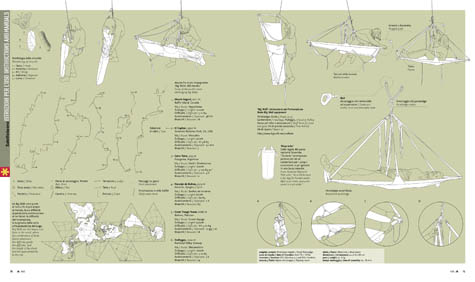 [Image: From an article by Jonathan Olivares, in Abitare; view much larger!].
[Image: From an article by Jonathan Olivares, in Abitare; view much larger!].Viewed architecturally, these examples of high-tech camping gear – capable of housing small groups of people on the vertical sides of cliffs, as if bolted into the sky – begin to look like something dreamed up by Archigram: nomadic, modular, and easy to assemble even in wildly non-urban circumstances. This is tactical gear for the spatial expansion of private leisure.
There are about a million implications here – including, at the very least, the question of whether or not architects should be involved in designing tents for North Face or for REI. If Zaha Hadid can design desk lamps and Frank Gehry, jewelry – and Michael Graves, teapots – then why can't, say, Jean Nouvel design a new series of outdoor recreational equipment, including tents, portaledges, platforms, and hammocks?
In fact, Jonathan Olivares, the author of the piece, describes the invention of the portaledge as follows: "Drawing from hammocks, cots, tents and sail construction, a generation of climber-designers invented a new typology: the portaledge." As such, the portaledge already has a fascinating design genealogy – one that includes the B.A.T. tent, the LURP, so-called "Cliff Dwellings" equipment, and tube-framed, waterproof tepees – but get some architects involved with this and see what happens.
Unless, of course, this is yet another case where architects have fallen behind the other design fields, too obsessed with accurately quoting Gilles Deleuze to notice that the world has been revolutionized. All sorts of amazing new tools, techniques, materials, shapes, and spaces were being framed and even mass-manufactured out there, for decades, but architects were all cooped up, underlining things for each other in the library.
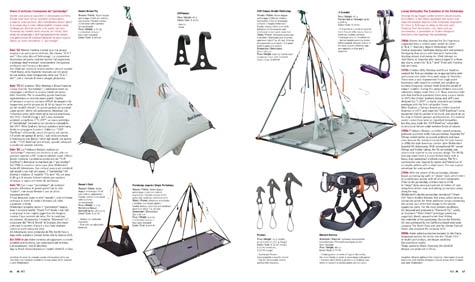 [Image: Another spread from Abitare, an article by Jonathan Olivares; view larger!].
[Image: Another spread from Abitare, an article by Jonathan Olivares; view larger!].In any case, I suppose one could say that this tent, below, the Dyad 22 by North Face, looks vaguely like some sort of microlight architectural folly designed by Neil Denari for the beaches of Southern California –
 [Image: The Dyad 22 by North Face].
[Image: The Dyad 22 by North Face].– and these tents, the Domes 5 and 8, also by North Face, look like, say, Buckminster Fuller in collaboration with Shigeru Ban. Or: if Buckminster Fuller and Shigeru Ban came together to franchise the design of London's Serpentine Pavilion one summer, perhaps this is what they would make.
Leading to the question: are tents an example of franchise architecture?
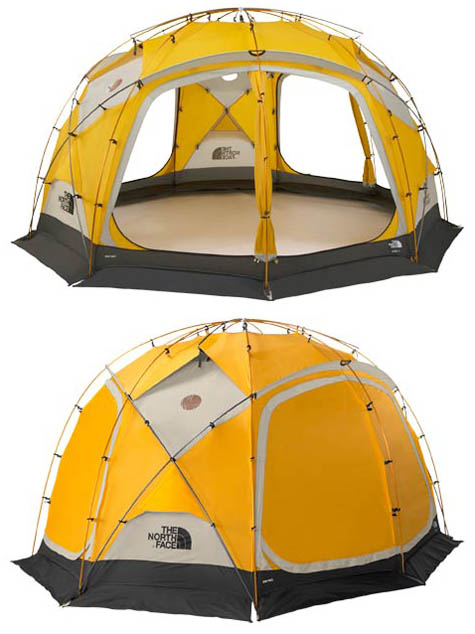 [Image: The Dome 5 and Dome 8 by North Face].
[Image: The Dome 5 and Dome 8 by North Face].So why aren't architects involved, as far as I'm aware, in the portable, modular architecture market known as high-end camping gear?
You ascend to the top of Mt. Everest... sleeping in a tent by Greg Lynn. Your sleeping bag is by OMA. Your best friend is comfortably slumbering beside you in a tent designed by LOT-EK.
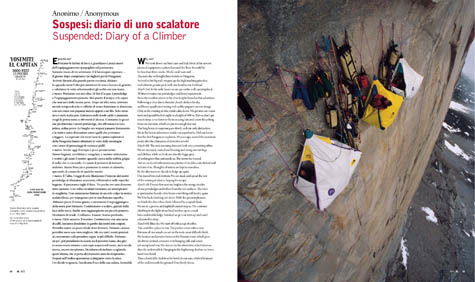
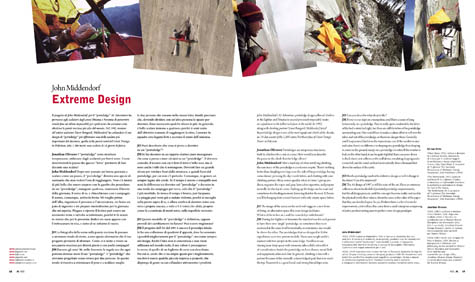 [Images: Two spreads from Abitare; view larger: top and bottom].
[Images: Two spreads from Abitare; view larger: top and bottom].But Abitare's article also implies something like the opposite of what I've written above: in other words, if high-tech camping gear used for vertical mountain ascents is actually a form of architectural technology, and thus worthy of being covered and critiqued by architecture magazines, then architects themselves should find more uses for such gear in their designs.
Rather than design camping gear, then, they should design with camping gear, filling private homes and office high-rises with unexpected tent-like rooms and rapidly deployed nylon conference facilities. You carry your boardroom around in your briefcase, installing it up on the roof when summer allows.
Or, perhaps, you construct a 21-story bare steel frame somewhere on an empty lot in New York City. It has no walls or floors; it is just a vast and abstract grid of I-beams, welded throughout with anchorage points. Using portaledges and tents, the inhabitants of this empty frame, like people from a fever dream by Yona Friedman or Constant, come in and colonize the structure, installing themselves at odd angles with carabiners and clips, bungee cords and tactical ropes, paying rent only on the spatial volume that the resulting structures occupy. $10 per cubic foot.
The grid – the structure – is taken care of. Architecture becomes nothing but the process of designing better tents. Flexible interiors. Sewn space.
So is high-tech 21st century camping gear exactly what the 1960s architectural avant-garde had been looking for? The portaledge as vertical utopia.
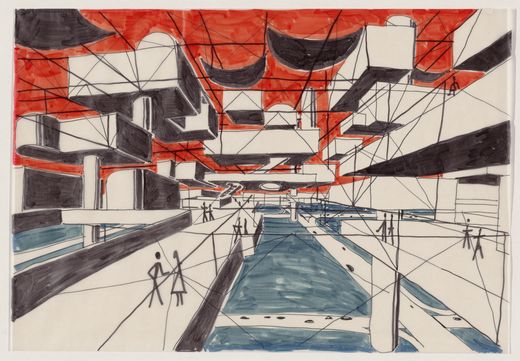 [Image: Spatial City by Yona Friedman: "The framework was to be erected first, and the residences conceived and built by the inhabitants inserted into the voids of the structure." Courtesy of the Museum of Modern Art].
[Image: Spatial City by Yona Friedman: "The framework was to be erected first, and the residences conceived and built by the inhabitants inserted into the voids of the structure." Courtesy of the Museum of Modern Art].To a certain extent, though, this reminds me of my experience just last week as a judge for the Design Village 2008: Mission to Mars competition, photographs of which can be found here. With some obvious exceptions, that contest gave us the tent as avant-garde – and even extra-planetary – architecture. In one case, it was the tent as full-fledged micronation, flirting with new definitions of political sovereignty.
Perhaps 2009 will be the year tent design explodes across architecture schools, worldwide.
Given zero insurance liability, then, could you arrange for a new, annual architecture competition, sponsored by REI, the point of which is to ascend Yosemite's Half Dome or El Capitan using only home-made, microlight portaledge technology? If you fall, you lose. You have to make it to the top within seven days – and you have to stay there for another three.
Then you have to make it back down.
 [Image: From Abitare; view larger].
[Image: From Abitare; view larger].All these instant cities of tents and portaledges, moving up and down mountainsides around the world, like Walking Cities, the urban condition gone nomadic – the new, vertical suburb, till now so architecturally underexplored.
(Original articles curated by Anniina Koivu. With huge thanks to Fabrizio Gallanti from Abitare for emailing me the page spreads!)
No comments:
Post a Comment